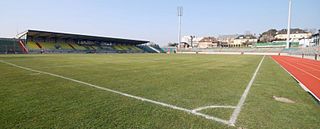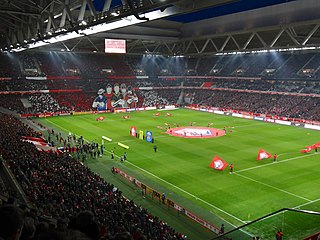
Luxembourg, also known as Luxembourg City, is the capital city of Luxembourg and the country's most populous commune. Standing at the confluence of the Alzette and Pétrusse rivers in southern Luxembourg, the city lies at the heart of Western Europe, situated 213 km (132 mi) by road from Brussels and 209 km (130 mi) from Cologne. The city contains Luxembourg Castle, established by the Franks in the Early Middle Ages, around which a settlement developed.

The Luxembourg national football team is the national football team of Luxembourg, and is controlled by the Luxembourg Football Federation. The team plays most of its home matches at the Stade de Luxembourg in Luxembourg City.

The Stade Josy Barthel is the former national stadium of Luxembourg, and the former home of the Luxembourg national football team. The stadium, which also hosted rugby union and athletics events, is located on route d'Arlon, in the Luxembourg City quarter of Belair. Following the opening of the Stade de Luxembourg in September 2021, the stadium and its grounds are currently due for demolition and redevelopment, to be ultimately replaced with a new mixed use neighbourhood named "Wunnquartier Stade".

Stade de France is the national stadium of France, located just north of Paris in the commune of Saint-Denis. Its seating capacity of 80,698 makes it the largest stadium in France. The stadium is used by the French national football and rugby union teams for international competitions. It is the largest in Europe for athletics events, seating 77,083 in that configuration. During other events, the stadium's running track is mostly hidden under the grandstands.

The Stade Vélodrome, known for sponsorship reasons as the Orange Vélodrome since June 2016, is a multi-purpose stadium in Marseille, France. It is home to the Olympique de Marseille football club of Ligue 1 since it opened in 1937, and has been a venue in the 1938 and 1998 FIFA World Cups; the 1960, 1984 and 2016 editions of the UEFA European Championship; and the 2007 and 2023 Rugby World Cup, and football at the 2024 Summer Olympics. It occasionally hosts RC Toulon rugby club of the Top 14. It is the second largest stadium in France, behind Stade de France in Saint-Denis (Paris), with a capacity of 67,394 spectators. The stadium is also used regularly by the France national rugby union team.
Same-sex marriage has been legal in Luxembourg since 1 January 2015. A bill for the legalisation of same-sex marriages was enacted by the Chamber of Deputies on 18 June 2014 and signed into law by Grand Duke Henri on 4 July. Polling suggests that a majority of Luxembourgers support the legal recognition of same-sex marriage. Luxembourg was the last Benelux country, the tenth in Europe and the sixteenth in the world to allow same-sex couples to marry nationwide.

The Stade de la Beaujoire – Louis Fonteneau, mostly known as Stade de la Beaujoire, is a stadium in Nantes, France. It is the home of French football club FC Nantes, known as the canaries.

Pau Football Club, commonly referred to as Pau FC, is a professional football club based in Pau, capital of Béarn, France. Pau FC plays its home matches at the Nouste Camp and competes in Ligue 2, the second tier of French football. Nicknamed Les Maynats, Pau FC traces its origins to the patronage of the Bleuets de Notre-Dame, officially founded in 1920 in the Mayolis district. By the onset of the 1958–59 season, the Bleuets had ascended to the highest amateur division in the French football league system, prompting religious authorities to acknowledge its sporting prowess, surpassing that of a mere local football club. Under the stewardship of its founding president, José Bidegain, the Bleuets de Notre-Dame's senior team transitioned into the Football-Club de Pau. By the 60s, they had settled in the Stade du Hameau, harbouring ambitions of turning professional.

Miloud Hadefi Stadium, is a multi-use stadium in Belgaïd, in the Bir El Djir suburb of Oran, Algeria. Completed in 2019, it is used mostly for football matches. It can hold 40,143 spectators. The value of construction work of the stadium was about 142.3 million US$, it is an olympic stadium with the athletics track and it is a part of the Miloud Hadefi Olympic Complex which is the first big complex in Algeria exceeding the Mohamed Boudiaf Olympic Complex in Algiers and it is also the first stadium entirely covered in Algeria. The stadium expected to be special for the Algeria national football team with Stade du 5 Juillet and Nelson Mandela Stadium, and also clubs of Oran especially MC Oran.

The Stade Pierre-Mauroy, also known as the Decathlon Arena – Stade Pierre-Mauroy for sponsorship reasons, is a multi-use retractable roof stadium in Villeneuve-d'Ascq in Northern France, that opened in August 2012. With a seating capacity of 50,186, it is the fourth-largest sports stadium in France and the home of French professional football club Lille.

The first generation of trams in Luxembourg ran from 1875 to 1964, before they were withdrawn from service and the tramways removed. A second generation of trams began operational service on 10 December 2017, along a new route that will, by early 2025, run from Luxembourg Airport to the Cloche d'Or business district, in Gasperich, serving the new national stadium, via Pfaffenthal-Kirchberg and Luxembourg railway stations. Additional lines are planned for the network both within Luxembourg City, as well as extending to Strassen and Esch-sur-Alzette.

Hocine Aït Ahmed Stadium is a football stadium located in Boukhalfa, Tizi Ouzou, Kabylia region, Algeria. Hocine Aït Ahmed Stadium is owned by the Algerian Ministry of Youth and Sport. With 50,766 seats, it is the third largest stadium in Algeria. The stadium was designed by United States-based construction company Atlas Group subsidiary Atlas Genie Civil Spa they completed the project in 2023 after 13 years of work as they started the construction on May 15, 2010. Replacing the 1 November 1954 Stadium, it is the new home ground of JS Kabylie, since 2024.
Stade TP Mazembe is a multi-use stadium located in the Kamalondo suburb of Lubumbashi, Democratic Republic of the Congo. Since its completion in 2012, it has mostly been used for football matches and is the home venue of TP Mazembe and CS Don Bosco. The stadium has 18,000 seats.

Football Club Chambly Oise, commonly known as Chambly, is a French professional football club based in Chambly in the Hauts-de-France region. Their home stadium is the Stade Walter-Luzi in the town, and they compete in the Championnat National 2, the fourth tier of French football, as of the 2024–25 season.

The Matmut Atlantique, also known as the Nouveau Stade de Bordeaux, is a football stadium in Bordeaux, France. It is the home of Championnat National 2 club FC Girondins de Bordeaux and seats 42,115 spectators. The sponsor Matmut is a French insurance company.

Alassane Ouattara Stadium, commonly known as the Olympic Stadium of Ebimpé and formerly as the National Stadium of the Ivory Coast, is a multi-purpose stadium in Ebimpé and Anyama, in northern Abidjan. It opened in 2020. The stadium hosts major football matches including home matches of the Ivory Coast national football team. Alassane Ouattara Stadium is owned by the Government of Ivory Coast. With 60,000 seats, it is the largest stadium in Ivory Coast and one of the most modern stadiums in Africa.
The Diamniadio Olympic Stadium, also known as the Stade Me. Abdoulaye Wade is a multi-purpose stadium, which can host football, rugby and athletics, in Diamniadio, in Dakar, Senegal. It is the national stadium of the Senegal national football team. The stadium which has a capacity of 50,000 designed by Tabanlıoğlu Architects and built by Summa. It will host the 2026 Summer Youth Olympics.

The Stade des Antonins is a stadium located in Nîmes, France. It has been the home ground of Championnat National club Nîmes Olympique since December 2022. The club began playing at the stadium following the closure of the Stade des Costières, in order to pave the way for the construction of the Stade Nemausus, with a projected completion in 2026.


















